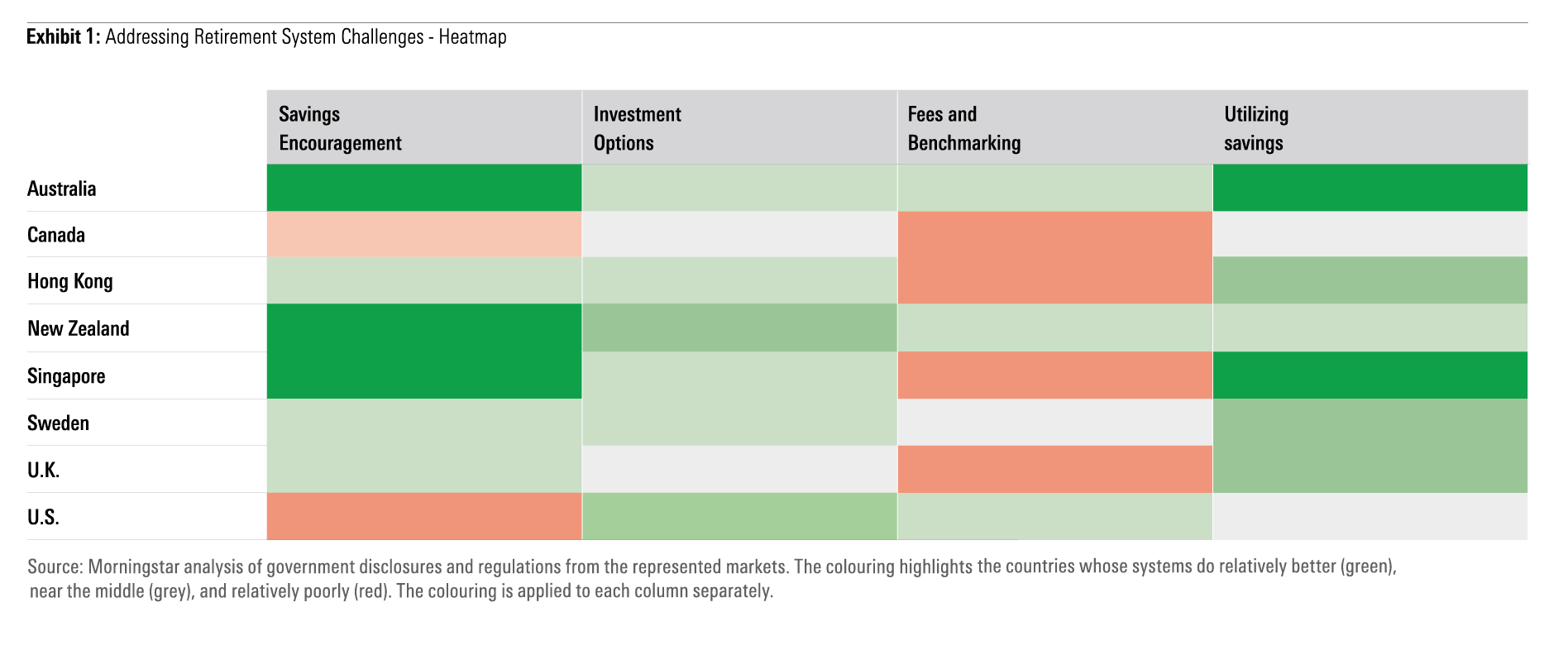How 8 Countries Address Retirement Saving Challenges
New Morningstar research examines how global workplaces are encouraging people to save more and earlier.

Investors in many markets are facing a common challenge: increasing responsibility for building savings to meet their needs in retirements that are lasting longer.
The fuel behind this fire comes from multiple sources: Public or social security pensions often provide no more than a basic retirement income, fewer companies are offering defined-benefit schemes to their workforce, and people are simply living longer.
Most countries operate some form of a three-pillar retirement framework:
- a social security pillar;
- occupational- or workplace-related savings; and
- personal or individual savings.
Optimizing each of the pillars and their interaction is crucial to ensuring positive retirement outcomes.
In a new paper, we specifically examine the second pillar and the workplace retirement systems in eight countries spanning the Americas, Europe, and Asia.
The countries—Australia, Canada, Hong Kong, New Zealand, Singapore, Sweden, the United Kingdom, and the United States—all have effective retirement systems that are often cited in independent studies as among the best-in-class frameworks in their regions. Rather than attempting to rank them based on differences, which might overly emphasize one approach, we have elected to observe and highlight both best practices and areas for improvement across four key components, illustrating these visually in a heatmap.

United States: A Solid Framework That Could Have Greater Reach
While U.S. workplace plans can be extremely competitive with the best in other markets, the initial step of access to a plan is not guaranteed.
The U.S. system is structured around incentives rather than mandates, which means that many workers don’t have access to a workplace plan and many don’t use one even if they do. Some states have sought to address this issue by introducing mandates for employers in their jurisdictions; however, the type of plan that states can mandate has significant lower annual contribution caps, limiting effectiveness. There is positive movement on the federal legislation front, with the introduction of pooled employer plans and proposals that would require new plans to auto-enroll their employees.
For those with access to a workplace plan, the investment options available must be selected with a fiduciary duty. Target-date funds are the most common default for plans with auto-enrollment, providing an asset allocation calibrated based on each worker’s years to retirement. Most plans offer a reasonable number of alternatives, providing flexibility for those looking to customize their investment strategy but without so many overlapping options that it creates confusion.
As for the cost of the investments, overall market competition has lowered fees across the U.S. fund landscape, and this trend has similarly lowered them inside retirement plans. An additional driver is the fiduciary duty required of plan sponsors. When it comes to benchmarking, workers are provided with annual disclosure on their plan costs and the performance of the investments relative to comparable benchmarks.
In terms of utilization of savings, access to workplace plan assets is allowed before retirement for emergent expenses, education, and qualifying home purchases. Employees may also have the option to take a loan against their retirement plan rather than directly withdraw their money, and then replace the loan amount within the tax-advantaged account. Retirees will often have multiple options for drawing down their balance, and independent advice is often needed to identify the best option for each individual’s circumstances.
Move to Defined-Contribution Plans Highlights Individual Responsibility
We find that the defined-contribution scheme is already thriving in some markets and at a more embryonic stage in others. In large part, this is shaped by the extent to which social security pension schemes provide, or have historically provided, a significant proportion of individuals’ retirement income.
A key tenet of the move to defined-contribution plans is that investment risk is put squarely on individuals. On top of that, workers must navigate a complex web of rules and options to optimize their savings. Getting unconflicted fiduciary advice to workers and retirees cost-effectively is a resulting challenge that still eludes most countries.
How Much Choice Is Too Much in Retirement Savings?
While choice is good, especially for experienced investors, too much choice is counterproductive, particularly for inexperienced investors. Some countries are better than others at optimizing plan choices so that participants are more likely to select a high-quality, low-fee investment or be defaulted into such an option.
In the same way that workers can be faced with too much choice within a plan, it’s also easy for them to accumulate multiple workplace plans and for that fragmentation to erode their savings. Minimizing the number of separate plans that individual workers have helps lower costs and increases engagement. Countries have tried various approaches, such as plan-follows-member, consolidating legacy plans into a “paid-up” plan, and auto-transferring small orphaned plans to an individual’s current or central plan.
How Countries Aim to Get People Saving Earlier
In the countries that have adopted them, auto-enrollment programs have been very effective at getting more people saving earlier. Plus, incremental changes to the programs continue to enhance the experiences of more workers. We find a growing number of examples seeking to engage members as retirement approaches but a dearth of initiatives to engage younger people in retirement saving.
The long-term nature of retirement saving can paradoxically create a savings disincentive for workers deterred by introducing a barrier to accessing their savings. Some countries alleviate this to different degrees by allowing early access to retirement savings in certain circumstances, but there is a delicate balance between this and preventing people from depleting their retirement income by using too much for other purposes.
Reducing Complexity as a Maxim
A common challenge we observed across heterogeneous retirement frameworks is complexity. They generally operate within complex rules and offer investment options that are not necessarily intuitive to inexperienced investors. Together, these factors make it challenging to ascertain how best to both accumulate, and then decumulate, retirement savings.
Overall, the hallmarks of the best-placed workplace schemes are government-mandated contributions; savings incentives, such as tax breaks or government contributions and employer-contribution-matching programs; and transparent oversight or benchmarking of scheme funds’ performance and costs.
The author or authors do not own shares in any securities mentioned in this article. Find out about Morningstar’s editorial policies.

/s3.amazonaws.com/arc-authors/morningstar/f3c31470-cc00-45ac-b20f-d2928ec12660.jpg)
/s3.amazonaws.com/arc-authors/morningstar/db801d63-4948-4a74-93bb-163e11d17dc4.jpg)
/cloudfront-us-east-1.images.arcpublishing.com/morningstar/YBH7V3XCWJ3PA4VSXNZPYW2BTY.png)
/d10o6nnig0wrdw.cloudfront.net/04-24-2024/t_a8760b3ac02f4548998bbc4870d54393_name_file_960x540_1600_v4_.jpg)
/cloudfront-us-east-1.images.arcpublishing.com/morningstar/O26WRUD25T72CBHU6ONJ676P24.png)
:quality(80)/s3.amazonaws.com/arc-authors/morningstar/f3c31470-cc00-45ac-b20f-d2928ec12660.jpg)
:quality(80)/s3.amazonaws.com/arc-authors/morningstar/db801d63-4948-4a74-93bb-163e11d17dc4.jpg)